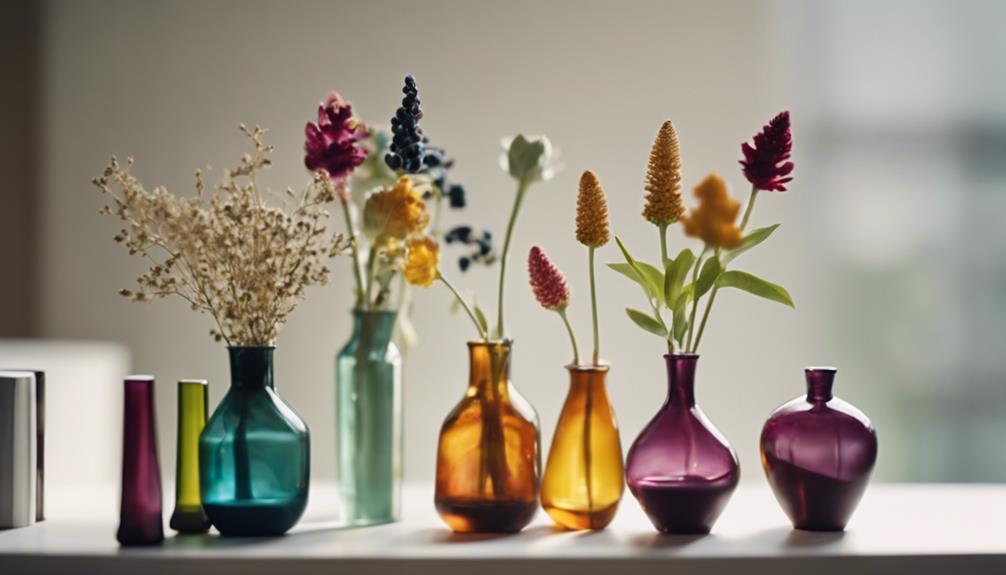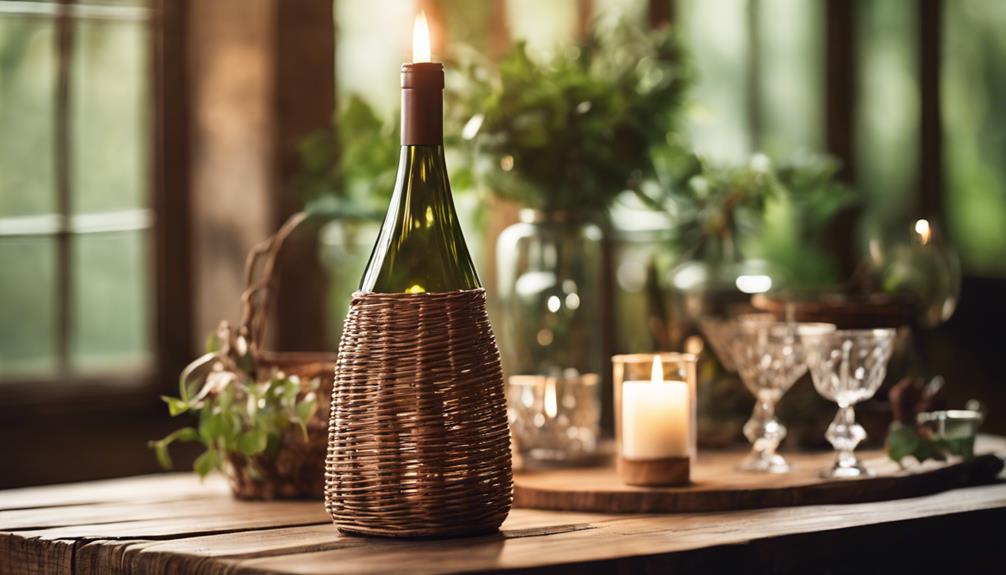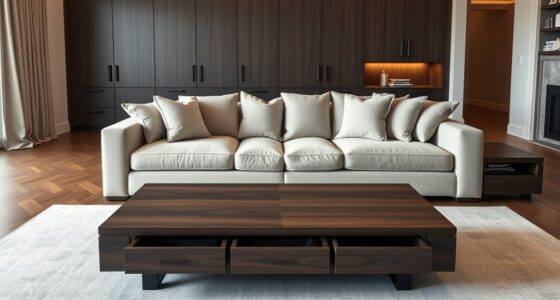A stylish pot rack can transform your kitchen into a stunning culinary haven. Whether you choose a wall-mounted, ceiling-hung, or freestanding design, it enhances both functionality and flair. Keep your pots within reach to streamline cooking and free up counter space. Make sure to evaluate height and clearance for safe and comfortable access. Adjustable racks can be especially handy, allowing you to customize the fit for your space. Plus, they serve as eye-catching decor that adds a personal touch. Curious about how to choose the perfect one for your kitchen? You'll discover plenty more insights ahead!
Key Takeaways
- Choose a sleek, wall-mounted or ceiling-mounted pot rack to enhance kitchen style while maximizing space and accessibility for cookware.
- Opt for customizable finishes and materials like metal or wood to seamlessly match your kitchen decor and elevate the overall aesthetic.
- Consider adjustable racks for tailored height modifications, ensuring convenience and functionality for various cooking tasks in your kitchen.
- Select a pot rack with sufficient weight capacity to accommodate heavier cookware, ensuring durability and safety in your kitchen setup.
- Research trending designs and styles to incorporate modern elements, making your pot rack a stylish focal point in your kitchen space.
Types of Pot Racks
There are several types of pot racks available, including wall-mounted, ceiling-mounted, and freestanding options, each designed to suit different kitchen layouts and styles.
Wall-mounted pot racks are perfect for maximizing space in smaller kitchens, as they keep pots and pans within easy reach while freeing up valuable counter space.
Ceiling-mounted racks, on the other hand, add a dramatic touch to your kitchen and are great for showcasing your cookware collection. They work well in larger, open spaces where you can hang your pots and pans above an island or work area.
Freestanding pot racks offer flexibility, allowing you to place them anywhere in your kitchen. They come in various styles, from simple designs to more elaborate wrought iron options that can enhance your kitchen decor. Specialty designs, like Rooster and Sassafras Forged Leaf pot racks, add a unique artistic flair while maintaining functionality.
When choosing pot racks, consider the materials used, such as durable copper or iron, which not only look great but also stand the test of time.
With options available at various price points, you're sure to find a pot rack that fits your style and budget.
Placement Considerations
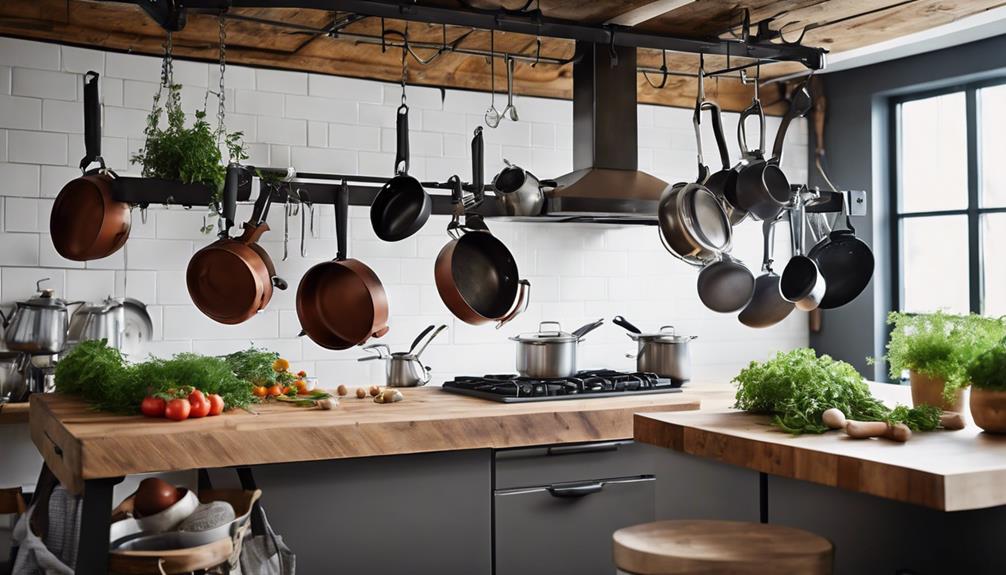
When you're deciding where to place your pot rack, think about ideal installation locations like above kitchen islands or prep areas for easy access.
You'll also want to make sure it's mounted safely, keeping it away from busy pathways and at the right height for comfort.
Remember to take into account clearance and accessibility, so your pots and pans are within reach without any hassle.
Ideal Installation Locations
Choosing the right location for your pot rack is essential for maximizing both functionality and accessibility in your kitchen. Think about where you'll get the most use out of it. Here are three ideal installation locations to contemplate:
- Above Kitchen Islands: If you have a kitchen island, installing your pot rack above it provides easy access while cooking, making it a central hub for meal prep.
- Prep Areas: Positioning your pot rack above your main prep area keeps your most-used pots and pans within arm's reach, speeding up your cooking process.
- Between Cabinets: If you have limited wall space, reflect on mounting your pot rack between cabinets. This not only saves space but also adds a stylish touch to your kitchen design.
Before settling on a spot, make sure you measure your ceiling height and allow for comfortable access.
Avoid placing your pot rack in busy pathways to minimize accidents.
With these considerations in mind, you can create a more efficient and visually appealing kitchen setup.
Safe Mounting Height
To guarantee safety and accessibility, mount your pot rack at about 42 inches above your counters, allowing for easy access while preventing accidents. This safe mounting height guarantees you won't have to stretch or strain while reaching for your pots and pans.
When considering placement, keep the pot rack away from busy pathways in your kitchen. This minimizes the risk of collisions, especially when you're cooking or moving around. Additionally, make certain you have adequate ceiling height; typically, you'll need at least 8 inches of clearance above the pots and pans.
Think about your own reach when determining the perfect height. It's a good idea to add 6-10 inches to your height for ideal accessibility. For example, if you're 5'6', consider mounting your rack around 48 inches high.
Before installation, measure the available clearance by subtracting the height of your pot rack from the total ceiling height. This step confirms that your chosen location provides a comfortable fit, guaranteeing your kitchen remains both stylish and functional.
With these considerations in mind, you'll achieve the perfect safe mounting height for your pot rack.
Clearance and Accessibility
Finding the right clearance for your pot rack is essential for guaranteeing it fits seamlessly into your kitchen while remaining easily accessible. Proper placement not only enhances the style of your space but also promotes safe and efficient cooking.
Here are three key considerations for clearance and accessibility:
- Height: Mount your pot rack about 42 inches above countertops. This height allows you to reach your pots and pans comfortably while guaranteeing guests can move freely underneath without bumping their heads.
- Space: Confirm there's at least 8 inches of clearance below the rack for hanging pots and pans. This prevents any obstruction while cooking and keeps your kitchen looking organized.
- Pathways: Position your rack away from busy kitchen pathways. This reduces the likelihood of accidents and keeps your movement within the kitchen clear and efficient.
Choosing the Right Size
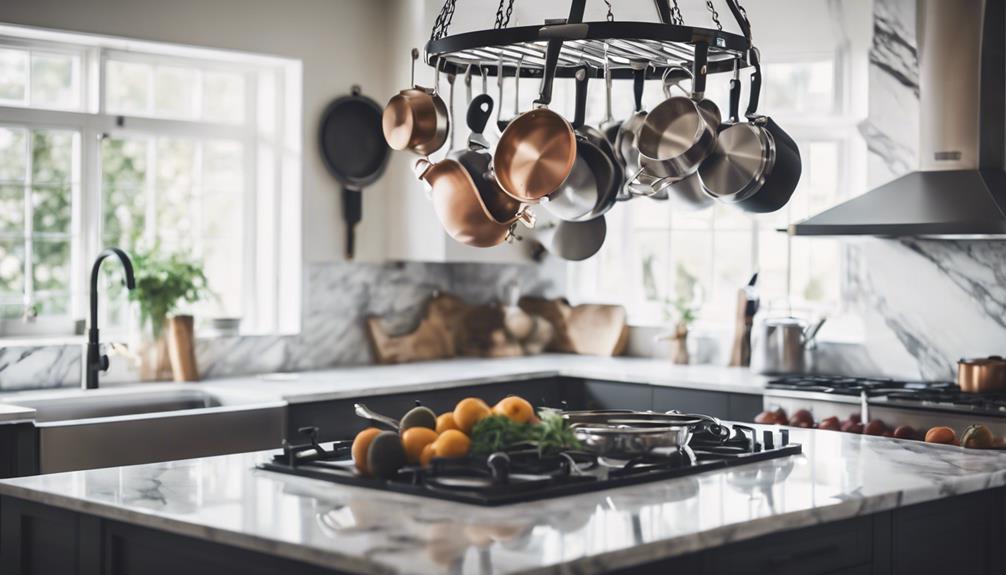
When you're choosing the right size for your pot rack, accurate measurements are essential.
You need to take into account how much clearance you'll need for your pots while also factoring in your ceiling height.
Don't forget that adjustable rack options can provide a custom fit for your space!
Measure Your Space Accurately
Accurate measurements are vital for selecting the right size pot rack that fits your kitchen and meets your cooking needs. Before you decide on a pot rack, take the time to measure your space correctly. Here are three key factors to take into account:
- Ceiling Height: Measure the distance from your kitchen floor to the ceiling. This helps determine how high your rack hangs and guarantees it won't obstruct your movements.
- User's Reach: Add 6-10 inches to your height to find the ideal clearance. This guarantees you can easily access pots without straining or stretching.
- Clearance Below the Rack: Allow for at least 8 inches of clearance below the rack for pots. This space is essential for both safety and accessibility.
Once you have these measurements, subtract the height of the pot rack from your total available clearance to find the best placement.
Don't forget to mount the rack approximately 42 inches above countertops to keep it out of the way for guests.
Taking these steps will assure that you choose a pot rack that fits perfectly and enhances your kitchen's style.
Consider Pot Clearance Needs
Guaranteeing your pot rack has enough clearance is essential for easy access and safe use in your kitchen. First, measure your ceiling height and consider your reach to determine the ideal installation height. You should allow approximately 8 inches of clearance below the rack for pots to hang freely. A good rule of thumb is to add 6-10 inches to your height to find that perfect hanging spot.
After measuring, subtract the height of the pot rack from the available clearance to guarantee you have enough space for easy access to pots and pans. Remember, extra clearance enhances your kitchen's functionality and accessibility, making it a joy to cook and entertain.
Here's a quick reference table to help you with your pot clearance needs:
| User Height | Recommended Hanging Height | Minimum Clearance Below Rack |
|---|---|---|
| 5'0' | 62-64 inches | 8 inches |
| 5'5' | 64-66 inches | 8 inches |
| 6'0' | 66-68 inches | 8 inches |
| 6'3' | 68-70 inches | 8 inches |
| 6'5' | 70-72 inches | 8 inches |
Adjustable Rack Options Available
After considering your pot clearance needs, exploring adjustable rack options can help you find the perfect fit for your kitchen space. These racks allow for height modifications, making it easier to tailor the setup to your specific requirements.
When selecting an adjustable rack, keep these key points in mind:
- Ceiling Height: Measure your ceiling accurately. Low-ceiling adjustable options are available for spaces below 9 feet, ensuring accessibility.
- Pot Space: Allow for at least 8 inches of space below the rack for easy access to your pots.
- Accessories: Some racks may require additional accessories to achieve your desired height, so factor this into your budget.
Mounting Techniques
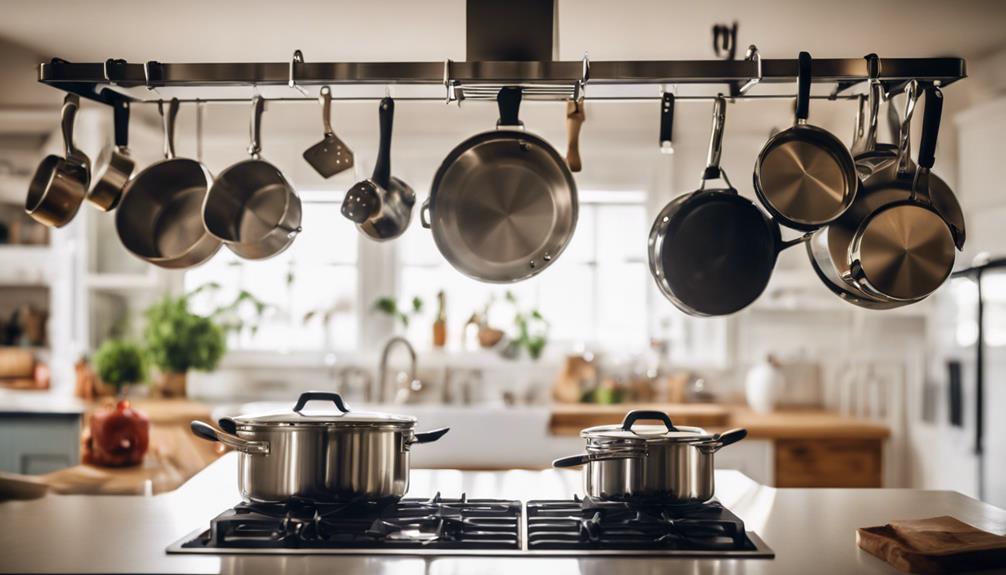
To securely mount your pot rack, you need to fasten it into solid wood or ceiling joists, ensuring it can handle the weight of your cookware.
The mounting method you choose will depend on the orientation of the joists in your kitchen. If your pot rack is mounted parallel to the joists, you'll want to locate the joists and use appropriate mounting hardware to secure it. For racks mounted perpendicular to the joists, ceiling plates with eye bolts are a great option, providing a solid anchoring point.
When selecting your mounting hardware, make sure it matches the weight capacity of your pot rack. Using the right screws, anchors, and brackets is essential for safety and durability.
Don't forget to check the stability and tightness of the mounting hardware regularly after installation. This step is important in preventing accidents and ensuring your pot rack stays securely in place.
Adjustments for Ceiling Height
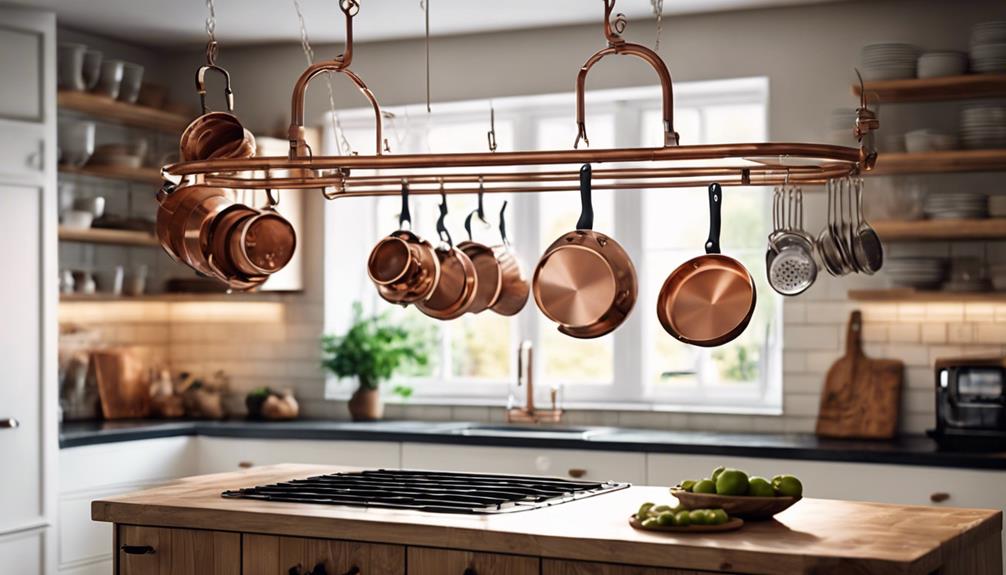
When dealing with varying ceiling heights, adjusting your pot rack can greatly enhance both functionality and aesthetics in your kitchen. By considering adjustments for ceiling height, you'll guarantee your pot rack fits perfectly in your space. Here are some effective ways to customize your setup:
- Use chains: Chains offer flexibility for modifying the height of your pot rack. You can easily raise or lower it to suit your needs or accommodate changes in kitchen decor.
- Install extension hooks: These hooks come in various lengths and allow for custom fitting, guaranteeing ideal clearance for your pots and pans. They help you achieve the perfect height, making your kitchen more user-friendly.
- Explore adjustable options: Some pot racks come with additional accessories for height adjustments. While you may need to purchase these separately, they can greatly enhance the versatility of your pot rack.
Benefits of Pot Racks

Pot racks offer a range of benefits that can transform your kitchen into a more efficient and stylish space. With a pot rack, you'll enjoy easy access to your favorite cookware, keeping pots and pans within reach for those spontaneous cooking moments. This accessibility enhances your kitchen efficiency, making meal prep a breeze.
By maximizing vertical space, a pot rack helps reduce countertop clutter, creating a tidier and more organized workspace, especially in kitchens with limited cabinetry. You'll appreciate how much more room you have to work when your pots and pans hang above you.
Beyond functionality, pot racks serve as decorative elements. Depending on the design you choose, they can add a rustic or modern touch, enhancing your kitchen's overall visual appeal. You can even use a pot rack to accommodate various kitchen items beyond cookware, such as utensils and linens, making it a versatile organizational tool.
Installing a pot rack encourages creativity and personalization in your kitchen organization and decor. It allows you to showcase your style while optimizing storage, making your kitchen not just functional but a true reflection of you.
Design Trends

Modern kitchens are embracing design trends that feature sleek pot racks, blending functionality with style for a contemporary look. These racks aren't just practical; they also elevate the aesthetic of your kitchen. You'll find that the latest designs cater to various tastes and layouts, helping you make a statement.
Here are three key design trends to contemplate when choosing a pot rack for your space:
- Variety of Styles: From wall-mounted and ceiling-hung to freestanding options, there's a pot rack to suit every kitchen. Choose based on your layout and personal preference.
- Customizable Finishes: You can select finishes that match your existing decor, ensuring your pot rack complements your kitchen's overall style.
- Material Choices: Popular materials like metal, wood, and glass offer durability and enhance your kitchen's ambiance. Each material brings its unique flair, allowing you to express your personal taste.
Incorporating these trends into your kitchen won't only maximize storage but also bring a stylish edge to your cooking space. So, contemplate a pot rack that reflects your individual style while keeping your kitchen organized!
Purchasing Considerations
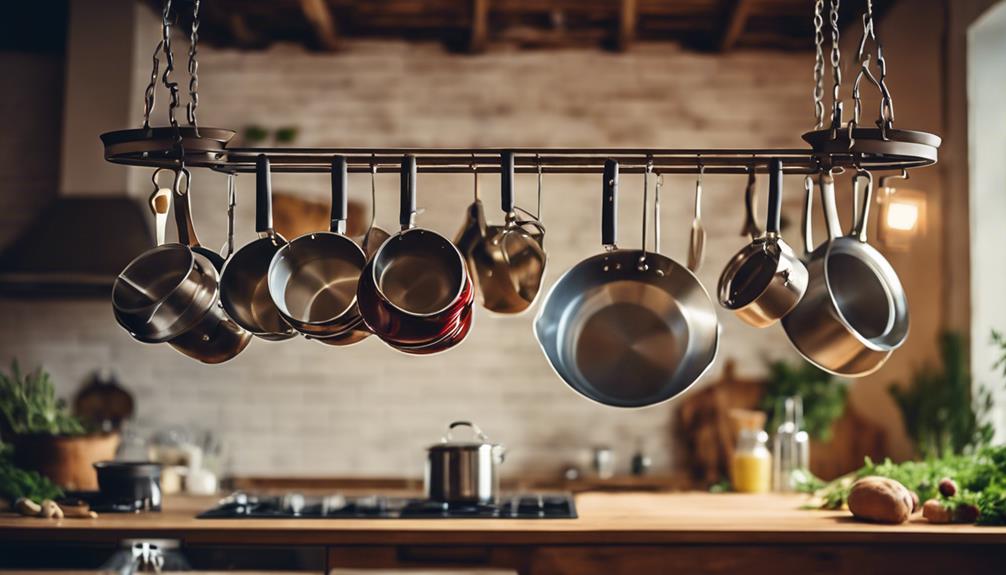
Selecting the right pot rack involves careful consideration of your kitchen's layout, style, and practical needs. Start by evaluating the dimensions of your space to find a pot rack that fits seamlessly. Think about the style that complements your kitchen decor, whether it's modern, rustic, or traditional.
Next, consider the weight capacity of the pot rack. You'll want something sturdy enough to support your heavier cookware, like the OROPY 38 inch Pot Bar Rack, which holds up to 80 pounds. This guarantees you can store all your pots and pans without worry.
Look for pot racks that come with easy installation options and necessary hardware. Clear instructions can make the setup process hassle-free, allowing you to enjoy your new rack sooner.
Don't forget to research customer reviews and ratings. A product like the OROPY pot rack boasts a high rating of 4.7 out of 5 stars from over 3,600 reviews, indicating durability and functionality.
Conclusion
Incorporating a pot rack into your kitchen can transform chaos into elegance, turning clutter into a statement piece.
Whether you opt for a sleek, modern design or a rustic, vintage look, each choice enhances your space.
Imagine the convenience of having your pots easily accessible, while also adding a touch of style.
With the right placement and size, you'll not only maximize storage but also elevate your kitchen's aesthetic, creating a perfect blend of functionality and beauty.

